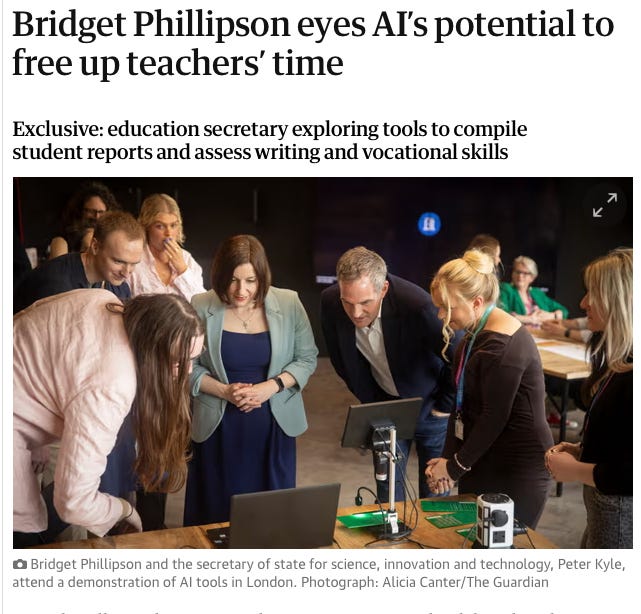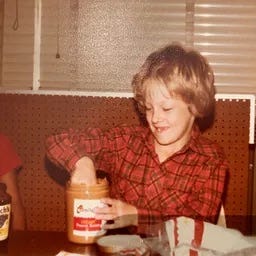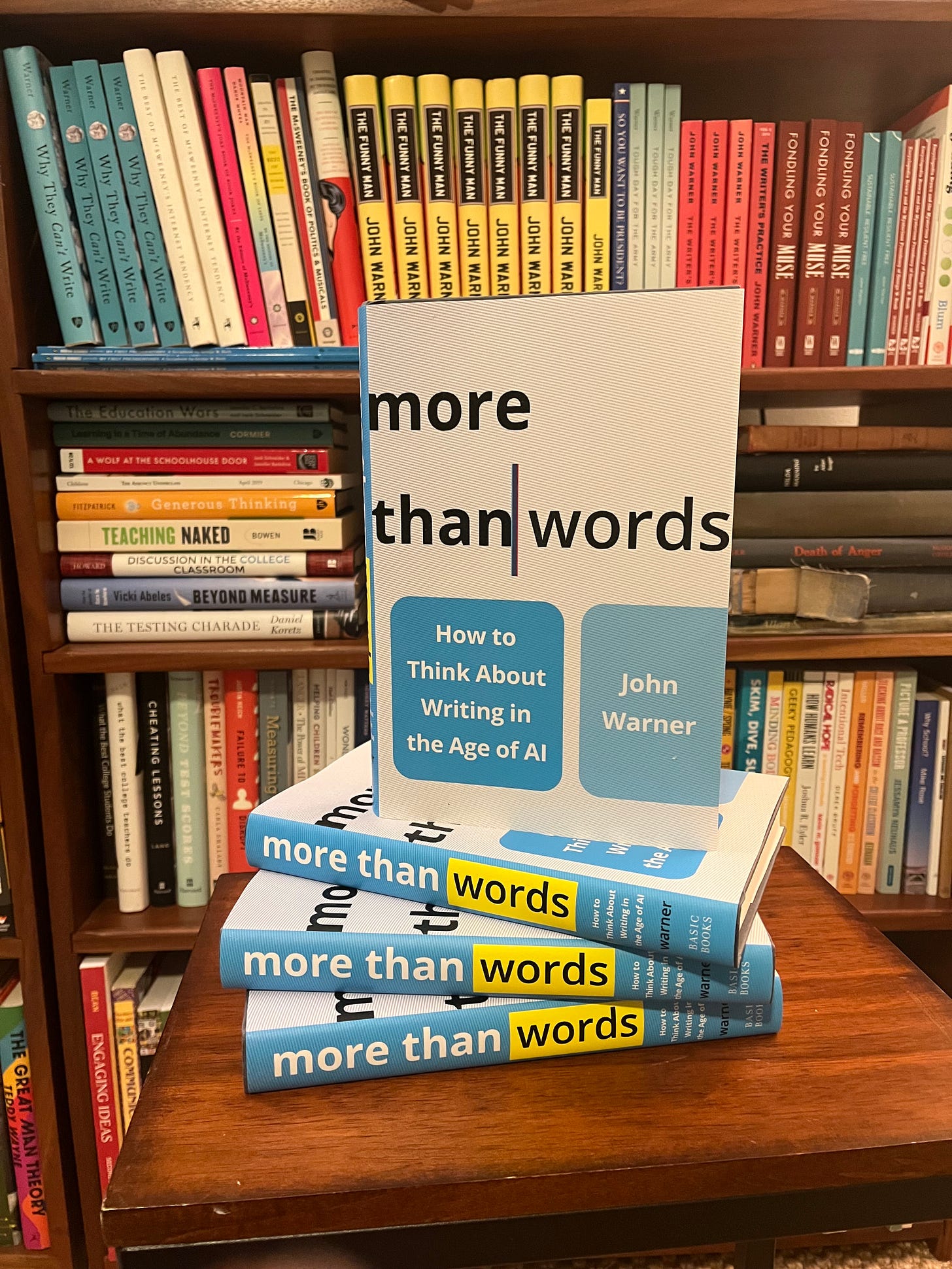This morning, I was prepared to dive into what I thought was a clever little bit of “persuasion” by saying that I was prepared to announce a fool-proof innovation in teaching writing, guaranteed to advance the skills of every student no matter their age, background, or interest.
The innovation is called the “Twelve Student Writing Classroom,” and it comes in an even more potent version known as the “Ten Student Writing Classroom.”
I was going to include all kinds of bits satirizing breathless business/hype speak about AI tutors while touting the benefits of close attention of human teachers to the work of their human students when it comes to helping those students build their writing practices. My intention was to puncture the enthusiasm around AI-mediated experiences while showing that something as straightforward as actually reading and responding to student writing would be “innovative” in a system that makes doing so far more difficult than it should be.
It would have deeply satisfied the people who agree with me that writing is an essentially human endeavor and that classrooms should be places of connection, communication, and mutual exchange.
It felt good just thinking about the piece going into the world and being seen by the people who agree with me, mostly teachers who appreciate what I have to say. It is fun to know you’re correct, particularly when you’re feeling a bit powerless to affect the trajectory of the things that matter to you as I have been lately
But then I saw this article published in The Guardian and I began to wonder: What’s the point?
The story is about officials in the United Kingdom, but the sentiments will be familiar to audiences in the U.S. and elsewhere. The government officials are encouraged about the potential for AI tools to increase the efficiency of evaluation of student work, including student writing.
After listening to one developer extol their AI writing analysis tool as “superhuman”, able to aggregate all the writing a pupil had ever done, Phillipson asked bluntly: “Do you know how much time it will have saved?”
It’s never clear what we’re supposed to do with this time that is going to be saved by AI. The field is littered with previous predictions of technology-mediated efficiency gains that only turned into more work for teachers.
And of course if we are truly as close to Artificial General Intelligence (AGI) as some believe we’re going to have a lot of extra time on our hands because the machines will do everything better than humans. Bill Gates thinks teachers and doctors will be made obsolete within ten years. If that comes true, these UK ministry folks are about to waste a lot of money on technology that itself will be obviated in fairly short order.
Maybe they should just hold tight for now and see how this stuff plays out.
I decided not to write that clever piece because I wasn’t feeling clever. I was feeling sad. The humor of the piece hinges on an audience believing something others don’t - that teaching is a human to human activity - and those of us on the inside of the joke would be affirmed, but those of us on the inside of the joke lack any real power to face down the threats of automated teaching when those threats are backed by government ministers and one of the richest people in the world.
It does not matter that, as
points out, Bill Gates has been always wrong, and never right about education. When it comes to educational research and “innovation” he is the piper who gets to call the tune.Thing is, it’s a lousy song, and everyone who is old enough to remember schools prior the reform movement knows it. Even those too young to know that previous reality knows it at least intuitively. This includes students who tell us this through their disengagement, as well as their school-related anxiety and depression.
It’s fun to mock the clear short-sightedness and, dare I say it, idiocy, but I couldn’t see where it was going to get me, other than a brief burst of attention on this platform.
So instead, I want to talk about two pictures. The first is that one above accompanying the article in The Guardian:
Consider this vision for education, a bunch of adults gathered around a screen displaying data gathered from students also working on screens, often in isolation from their peers, not even having the chance to gather with others or share their work beyond the algorithm. This is the promise of so-called “personalized learning” that Bill Gates has been wrong about for decades now.
Here’s another photo:
That’s me in Mrs. Goldman’s 3rd grade class. This story will be familiar to anyone who has read one of my books or heard me speak because I tell it all the time, but I tell it because it is meaningful, necessary.
This is the moment I learned how to write. Mrs. Goldman asked us to craft instructions for making a peanut butter & jelly sandwich, and then had us attempt to make those sandwiches following our own instructions to the letter. What you are seeing in this picture is a student who failed to include that you should use a knife to spread the peanut butter on the bread, and so he is knuckles-deep in a jar of Jewel-brand smooth.
There are other things we can notice. You can see the arm of one of my classmates that I’ve cropped out of the photo. I still know her name, even though you couldn’t say we were ever friends, and if we’ve laid eyes on each other even once since graduating high school, I don’t recall it. The miracle of the internet makes it easy to discover that she is an incredibly successful doctor with a position at a major research university, which is not surprising because as I recall she was the smartest kid in the class, and probably wrote that you need to spread the peanut butter on the bread with a knife.
You can see that this kid in the picture is smiling, and if you look close you can see that he’s smiling even though he is missing almost all of his upper teeth thanks to a skateboarding accident. I avoided smiling at all costs that year because one front tooth was sideways, while the other (once it finally arrived) stuck almost straight out. I would get braces (for the first time) the next year in 4th grade.
But that kid in that moment is having a good time and so he’s smiling. He’s learning something he never forgot, that writing has a purpose and an audience and if you don’t take care to attend to those things your writing may carry negative consequences, like resulting in an inedible PB&J and a (literal) mess on your hands.
This is learning. It is so far from what those UK ministers envision for the students of their country, or what Bill Gates envisions for the world, it’s like we are not talking about the same thing.
We have to start talking about the same thing.
There is another participant in the picture that isn’t captured by the scene, Mrs. Goldman, the picture taker. Obviously she felt compelled to capture these moments and in the tradition of film photography at the time, share the doubles of the prints with her students. My mom kept this photo for many years, turning it over to me as part of a keepsake book when I got married. I know Mrs. Goldman took pleasure in her work because she did it for many years and after the publication of Why They Can’t Write, I was able to connect with her and send a copy of the book.
Last week I received an email from my 7th grade pre-algebra teacher saying he enjoyed what I had to say in my Chicago Tribune column about the passing of sportswriter, John Feinstein. I was in his class over 40-years ago, but he remembers me and I remember him. He told me how much he’d loved his job over his many years of service, that it never felt like going to work. Next time I’m in town he offered to buy me a meal at Max and Benny’s, a Northbrook, Illinois institution with legendarily good matzo ball soup and a damn fine reuben that I haven’t eaten at for probably 35 years, but can almost taste just thinking about it..
Why is this not the goal of our education system, the building of relationships, experiences, memories, connections?
The stuff of life.
If you’re interested in a book about making sure writing remains a human enterprise in a world of syntax generators, check out my newly released More Than Words: How to Think About Writing in the Age of AI.









The image of my twin sister swishing toothpaste around in her mouth and spitting it out all over the bathroom counter (we were 8 or 10?) is indelibly etched into my mind because I forget to include the sink in my instructions for brushing teeth. Funny those things we remember. Learning is (literally) messy. It's why some of us have spent a lifetime doing it. It's the most fun you can have making a mess.
My high school history teacher is one of my few paid subscribers on Substack 🥰 Yay for human connections in education